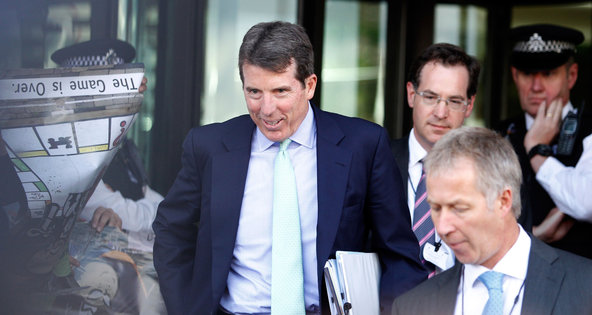 Paul Thomas/Bloomberg NewsRobert Diamond, the former chief of Barclays, appeared before a London panel investigating interest rates in July.
Paul Thomas/Bloomberg NewsRobert Diamond, the former chief of Barclays, appeared before a London panel investigating interest rates in July.
LONDON — In a report released early Saturday in London, British politicians said the former Barclays chief Robert E. Diamond Jr. had not provided lawmakers a full account of the actions inside the bank during recent hearings into the rate-rigging scandal.
The report also challenges some of Mr. Diamond’s assertions about the bank’s relationship with regulators. It also questioned the top leadership at the bank and the candor of Mr. Diamond’s testimony.
“Mr. Diamond’s evidence, at times highly selective, fell well short of the standard that Parliament expects,” Andrew Tyrie, the British politician who led the recent hearings, said in a separate statement.
Documents released by local authorities show that officials had questioned the culture at the top of the British bank as far back as 2010, though Mr. Diamond had said regulators were happy with the firm’s leadership.
The doubts about Mr. Diamond’s testimony come after several of Barclays’ senior executives, including its chairman, resigned last month. The firm agreed to a $450 million settlement with American and
British authorities over the manipulation of the London interbank offered rate, or Libor, one of the world’s most important benchmark rates.
Libor Explained
British lawmakers had called several of the firm’s executives and the country’s leading regulatory authorities to testify before Parliament’s Treasury Select Committee, which had been investigating the Libor scandal at Barclays.
The lawmakers’ latest report criticized Mr. Diamond’s recollection of concerns that regulators had raised when he was appointed chief executive, as well as issues with the culture at the British bank.
Also in his testimony, Mr. Diamond had said British authorities were pleased with his relationship with the Financial Services Authority, the country’s regulator. The regulators, however, testified that they had challenged the firm’s attitude toward risk and had called on Mr. Diamond to distance himself from colleagues in Barclays’ investment banking unit. In the latest report, it appears that lawmakers mostly sided with the authorities.
“It seems to us inconceivable that Mr. Diamond could have believed that the F.S.A. was satisfied with the tone at the top of Barclays,” the report said.
Mr. Diamond issued a sharply worded rebuke of the report.
“I am disappointed by, and strongly disagree with, several statements by the Treasury Select Committee,” Mr. Diamond said in a statement on Saturday. “There is little dispute that Barclays was both aggressive in its investigation of this matter and engaged in its cooperation with the appropriate authorities.”
The latest report also questioned the importance of a conversation that Mr. Diamond held with Paul Tucker, the deputy governor of the Bank of England, in 2008.
The discussion focused on the firm’s Libor submissions, and led to Jerry del Missier, a senior Barclays official, to ask some of the firm’s employees to alter their Libor rates. Mr. del Missier said he believed that he was acting on instructions from British government officials, though Mr. Tucker dismisses that contention.
Lawmakers said that Barclays’ employees had been manipulating rate submissions since 2007, and that Mr. del Missier’s ability to alter submissions showed a lack of regulatory compliance.
“It remains possible that the entire Tucker-Diamond dialogue may have been a smokescreen put up to distract our attention,” the report said. Poor judgment by the firm’s board led to a lack of controls, which could have stopped the rate manipulation from taking place, according to the report.
A Barclays spokesman said that the bank did not agree with all the report’s findings but was conducting an independent review of its business practices.
The report also highlighted failures by the Financial Services Authority to address the manipulation of Libor.
Concerns that firms were altering their Libor submissions were first brought to the attention of authorities in late 2007, according to regulatory filings. But British officials joined their American counterparts in investigating the abuses only in early 2010.
Adair Turner, chairman of the authority, told British lawmakers last month that regulators had not perceived Libor to be a major area of risk during the recent financial crisis.
“The manipulation was spotted neither by the F.S.A. nor the Bank of England at the time,” Mr. Tyrie said. “That doesn’t look good.”
The British government is reviewing how Libor will be set in the future. The inquiry may lead to greater regulatory oversight of the rate, while lawmakers are considering new laws that would make the manipulation of benchmark rates a criminal offense.
American and international authorities also continue to examine the actions of other global financial institutions, including Citigroup and HSBC. New York and Connecticut state regulators announced on Wednesday that they were widening their own rate-rigging investigations.
Article source: http://dealbook.nytimes.com/2012/08/17/in-report-british-officials-question-testimony-of-barclays-chief/?partner=rss&emc=rss